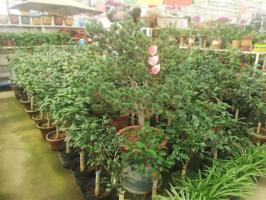Introduction
Gnats or fungus gnats are tiny flying insects that seem harmless but can become a nuisance when they invade your potted plants. They can breed in moist potting soil, and their larvae can damage the roots of plants. Getting rid of gnats from potted plants can be challenging, but there are several methods that you can use to eliminate them.
Cultural Control
One of the easiest ways to get rid of gnats is by implementing cultural controls. This involves altering the conditions that favor their reproduction in the first place. Start by reducing the amount of moisture in the soil by watering your plants less frequently. Overwatering can lead to excessively moist soil, which is a breeding ground for gnats. Secondly, avoid using organic materials such as decaying leaves or mulch around your potted plants. These materials can provide a food source for gnats and increase their population. Use clean potting mix that is free from fungus gnats and other pests.
Biological Control
Another effective method of getting rid of gnats from potted plants is by using biological control agents. Beneficial nematodes are microscopic organisms that seek out and destroy the larvae of gnats. These nematodes are available at most garden centers and can be applied to potted plants by mixing them with water and pouring them into the soil. The nematodes penetrate the larvae and release bacteria that cause the infective larvae to die within a few days. Doing this consistently can wipe out the entire population of gnats.
Mechanical Control
Sticky traps are another method of getting rid of gnats from potted plants. These traps are made of yellow or blue paper coated with a sticky substance that attracts and trap the gnats. Place these traps near the plants where gnats like to swarm and replace them every few days or when they become fully covered in insects. Another mechanical control method is simply removing the top layer of soil, including any weed or plant debris, and replace it with fresh soil.
Chemical Control
If the gnat infestation in your potted plants persists, you can opt for chemical control. Insecticides such as pyrethrum or neem oil can be sprayed on the soil, leaves, and stems of plants to kill the gnats. However, chemical control should be used as a last resort because it can be harmful to plants and beneficial insects.
Conclusion
In summary, getting rid of gnats from potted plants requires patience and consistency. Implement cultural controls to prevent their infestation, use biological or mechanical controls to eliminate them, and as a last resort, consider using insecticides. By following these methods, you can enjoy healthy plants without the nuisance of gnats, both in and out of your home.

 how many times do yo...
how many times do yo... how many planted tre...
how many planted tre... how many pine trees ...
how many pine trees ... how many pecan trees...
how many pecan trees... how many plants comp...
how many plants comp... how many plants can ...
how many plants can ... how many plants and ...
how many plants and ... how many pepper plan...
how many pepper plan...































